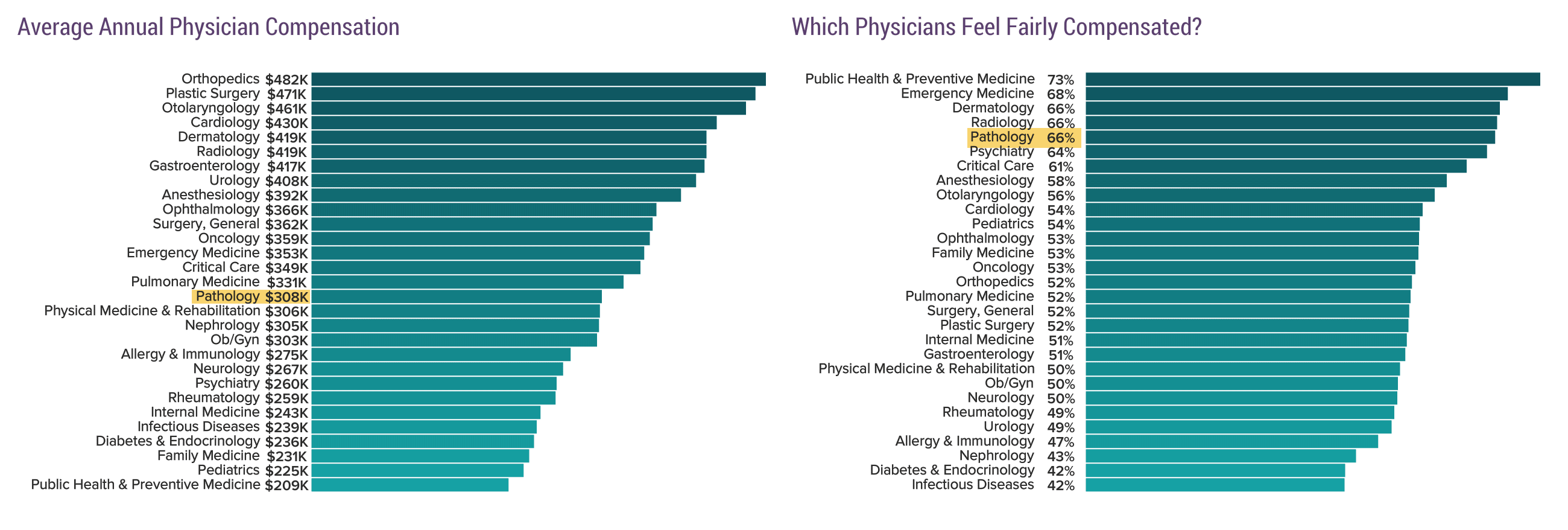- Home
- Member Resources
- Articles
- The State of Pathologists Job Market and Compensation
How I Came to Pathology
My road to pathology is different than many others. As a medical technologist, I knew that I was interested in pathology long before beginning medical school. I also knew that going back to school meant trading in my steady paycheck for a massive amount of student debt. Before taking on this new financial burden, I wanted to know that a career in pathology would be worth the risk and that I would not struggle to find a job or to receive a competitive salary. After some research, I was excited to discover that the job market in pathology was expanding and showed competitive pay. Over the past eight years, more and more jobs have become available, and the average salary has increased annually.
Who is Practicing Pathology?
The CAP’s 2017 Practice Characteristics Survey serves as a primary source for data that relates to currently practicing pathologists. It includes information on how they practice, how they are compensated, and tracks changes that are occurring in the workforce at large. There are nearly as many female pathologists in the workforce (46.8%) as male pathologists (51.6%). Additionally, nearly 90% of those in practice identified as working full-time, with only 0.4% reporting that they were unemployed or seeking employment. Those respondents working full-time averaged 49.2 hours per week in 2017 with no significant differences between genders. The largest percentage of pathologists work in a practice of between one and five full-time pathologists (40.6%). During this same period, 15% of respondents indicated that they had changed jobs or hired into their current role in the previous year. Of those hired, nearly 32% were new-in-practice pathologists, meaning they just finished training.
Pathologist Compensation
What is the Average Pay for a Pathologist?
The 2019 Medscape Physician Compensation Report ranks pathology sixteenth out of thirty medical specialties, with an average annual salary of $308,000. Most pathologists are satisfied with their salary, as pathology ranks fifth regarding feeling fairly compensated for their work. This likely results from a relatively shorter average workweek of 49.2 hours than other specialties, and because pathologists feel that they are getting paid “more per hour” than our peers in other specialties.
The CAP’s 2017 Practice Characteristics Survey presents a more in-depth look at pathologist compensation. The mean base salary for a full-time pathologist in 2017 was $271,144, with a median base salary of $245,000. Greater than half of respondents indicated that they received some form of cash compensation, that is, bonuses and incentive compensation. The average bonus was $69,537, with a median of $20,000. Another 16% of pathologists indicated that they received other income from professional pathology services beyond their base salary. The average amount of this compensation was $25,859, with an annual median of $7,000. The Total Cash Income, with all three forms of compensation combined, for a full-time pathologist in 2017 was $322,791 with a median of $280,000.
The average compensation differed based on practice setting. Full-time pathologists working in non-academic hospitals/medical centers and/or independent laboratories made substantially more than their academic-based peers.
The results of the Medscape Report and the Practice Characteristics Survey are compatible and likely reflect differences in sampled populations, for example, more academic physicians in the Medscape study. However, if we compare the 2017 and 2019 Medscape Survey data ($293k to $308k), we see the annual compensation for pathology continues to increase substantially. According to either model, pathology is a field that is well compensated for the work it does.
Pathologist Job Market Data
What Does the Job Market Look Like?
One of the most common myths about pathology is that it is a specialty in which there are no jobs available. While this may have been true in times past, we are seeing a steady increase in available positions for new-in-practice pathologists. The 2018 Practice Leader Survey Report provided by the CAP shows that nearly 40% of responding practices sought to hire at least one pathologist in the prior year (2017).
The 2018 Survey also provided a breakdown of the practice-types looking to hire at least one pathologist. Academic and non-academic practices were nearly evenly split in terms of seeking to hire. However, most new-in-practice pathologists were likely to be working in an academic setting. This may reflect the greater trend in pathology as more labs transition to an academic based setting. Other settings included central laboratories, forensic laboratories, and government or military hospitals.
Finally, the survey shows that the number of pathologists that were expected to be hired out-paced the number of pathologists expected to retire.This demonstrates that pathology is a growing field and that the demand for jobs extends beyond filling retiring positions.
What is the Job Search Experience for Current Residents?
In 2016, the CAP published a comprehensive review of five (5) years of data related to the perceived difficulty residents and fellows experienced while searching for a job. The data showed that the job market was remarkably stable, with an overall decrease in the perceived difficulty of finding a job. Majority of respondents had accepted positions (69%), and most were either satisfied or very satisfied (86-94%) with the position they accepted. The likelihood of accepting a position did not differ based on demographic characteristics such as age or gender.
Nearly two years later, data from 2017 and 2018 is encouraging, with more trainees reporting they were offered a position and describe the job search as easier than ever before.












